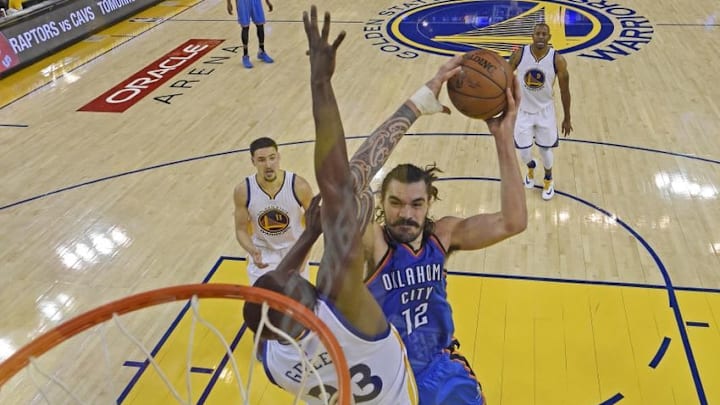
One of the biggest advantages for the Oklahoma City Thunder in their surprising Game 1 win over the Golden State Warriors was their ability to leverage their size. Usually, Golden State devours big lineups with speed and shooting, forcing opposing coaches to adjust. In Game 1, the Thunder were +13 in the 24 minutes Steven Adams and Serge Ibaka played together, and +8 in the 10 minutes Adams and Enes Kanter played together.
On paper, the Thunder have an enormous size advantage over the Warriors and it’s worth quantifying just what that size advantage is. To do so, I’ve updated a visualization I ran earlier this season which looks at the minute-weighted height by position for each team. The data uses listed player heights from Basketball-Reference and Nylon Calculus position estimates.
The visualization above, for the sake of curiosity, shows all 30 NBA teams. If you filter the view down to the Warriors and the Thunder you can see Oklahoma City’s size advantage in the frontcourt.

Golden State has an advantage in the backcourt, mostly the effect of Shaun Livingston as their backup point guard and Dion Waiters taking backup minutes at shooting guard for the Thunder. Oklahoma City is taller than average at all three frontcourt positions, the Warriors falling under that average. The biggest difference is obviously at power forward, with Draymond Green lining up against Nick Collison or, in this series, usually Kanter or Ibaka.
It’s no surprise that the Thunder play big and the Warriors play small — The Death Lineup and general smallball shenanigans have been a huge part of the Warriors success this season. They usually win those matchups against big lineups. The thing is, no one else is quite as big as the Thunder.
The Warriors have the smallest minute-weighted frontcourt in the league. The Thunder had the sixth-biggest, only the Minnesota Timberwolves were bigger in the Western Conference. To qualify, we’re talking about actual physical size here as opposed to style or skill set. The San Antonio Spurs generally play big but both David West and Boris Diaw are slightly shorter than the average power forward, LaMarcus Aldridge and Tim Duncan (if you believe both player’s listed heights of 6-11) are slightly shorter than the average center.
All told, by the minute-weighted averages during the regular season, the Thunder were about a combined four inches taller than the Warriors across the three front court positions.

All that length gives the Thunder an advantage on the glass, packing the paint to prevent driving lanes, and even forcing new rotational adjustments out of Steve Kerr and the Warriors.
Or, it may turn out that none of this matter. The size advantage for Oklahoma City only manifests if they can actually keep these players on the floor. That means Adams and Ibaka needs to be phenomenal defending in space, and Kanter needs to be sufficient (trying to keep our expectations realistic here). That means all three need to stay out of foul trouble. That trio was able hold their defensive integrity in the second half of Game 1 and it was one of the big differences. Holding that advantage long enough for the Thunder to win four games is a challenge of a different sort.
